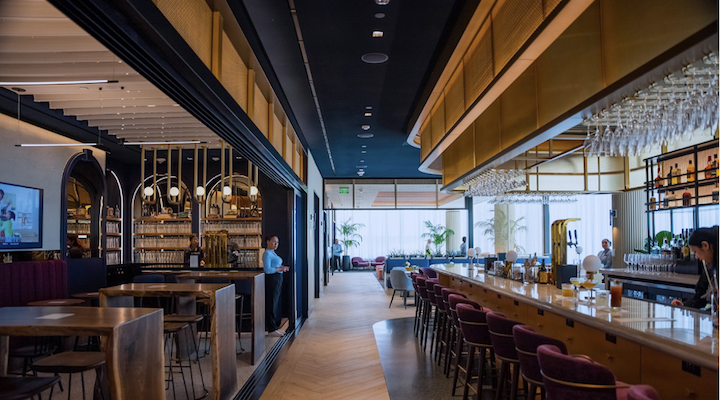
Chase Sapphire Lounge in Boston’s Logan International Airport. Photo by JP Morgan Chase
By James Cruikshank
Airline loyalty programs and their banking partners have begun waging war in airport hubs around the country by upgrading and opening new lounges with hopes of conciliating top members’ frustrations with club availability and quality.
Just last week, Delta unveiled a beautiful new 14,000-square-foot SkyClub in JFK’s Terminal 4. In May, JP Morgan Chase opened an equally alluring lounge in Boston’s Logan International Airport.
JP Morgan Chase’s lounge in Boston is the first for the bank, a notable development in a contest between banking partners to enter the airport hospitality sector. CitiBank opened the first of its growing Citigold Lounge line in 2018; it now has eight in the US and 27 worldwide. Capital One has continued to expand its network after it opened its first club in Dallas/Fort Worth last year, with plans to open soon in Denver and Washington D.C.
Airport lounges have been struggling to keep members satisfied for years. Steve Cosgrove, publisher for Airways Magazine and longtime AAdvantage Executive Platinum member, is one of the many flyers disappointed with their benefits.
“Sometimes you have to wait until two people leave an airport business class lounge before two others can enter,” says Cosgrove. “This new reality has negatively impacted loyalty programs. If you travel first class, the last thing you want to do is go to the lounge and wait to get in.”
Underneath the opulence of the revamped lounges is a bit of ingenious strategy. Airlines need loyalty, and lounges may be the fix.
Following financial releases during the pandemic, it has been no secret that airlines rely on revenues from their respective loyalty programs more than unwitting consumers often realize.
Borrowing Against Loyalty
After United reported a net loss of $2.6 billion in the second quarter of 2020 due to the pandemic, the company leveraged its MileagePlus program as collateral for a $6.8 billion bailout loan from Goldman Sachs. In the transaction, United was forced to reveal that MileagePlus was worth $21.9 billion – over double the airline’s entire market cap value on Mar. 31, 2020, which was calculated to be $9.16 billion.
Across the industry airlines copied the move by United, using their loyalty programs to preserve themselves during the pandemic. Airlines then lowered the requirements to maintain certain status tiers so travelers would not be wrongfully downgraded due to their lack of travel. That break ended in the first quarter of this year, and over 20 million flyers were downgraded as a result, putting the loyalty of millions in jeopardy.
Another factor fueling the need for new clubs was the overcrowding of Priority Pass and AMEX Centurion lounges. In 2016, Priority Pass partnered with JP Morgan Chase and Capital One ending long-time exclusivity with AMEX due to their increasingly popular Centurion lounges. Meanwhile, elite credit cards have skyrocketed in popularity, turning luxury into traffic jams at the door.
Now these moves are proving troublesome. This year, airlines ditched many of the special loyalty join deals from the pandemic. American raised the threshold for their Gold membership in Mar. 2022 from 30,000 points to 40,000. Delta will make a similar move by increasing the spending threshold for all their status tiers by 33% in 2024.
American also raised the membership costs for its Admirals Club lounges. On July 23rd, the company announced that the annual fee for the club would rise from $599 to $799 for annual renewal or from $59 to $79 for a day pass, making it the most expensive in the industry. Other carriers will likely follow suit.
The change arrived after customers complained to airlines of seemingly lowered value for their points as many new customers were able to snatch premium benefits.
Exclusive No More
“Now you go there, it’s no longer the first class lounge but the airline lounge, and it’s filled with first class passengers and people in coach who earned a pass to the lounge because they bought enough tacos at Taco Bell on their credit card.” Mr. Cosgrove colorfully added.
Airline loyalty programs have run into a psychological problem. They thrive on their pyramid-scheme style; top members remain content with exclusivity and world-class comfort, while lower-tier members remain hopeful that they, too, can achieve those benefits through long-term loyalty.
Yet, the system is thrown out of balance when the benefits are too easily accessed, an issue that COVID-19 exacerbated. Airports and airliners are now focusing on their terminal comfort to quell their customers’ dissatisfaction.
The Biden Administration allocated $1 billion to 99 airports for terminal refurbishment this year and thus far the money has been used to renovate some of the nation’s largest hubs. Record travel surges this year have generated staggering profits, too, adding to the cash pool.
Enter New Opulent Lounges
Airlines are scrambling to make lounges accessible and luxurious again, Meanwhile, banks are trying to get a piece of the action. While each tries to one-up the other, the loyalty industry is simultaneously responding to trouble leftover from the pandemic.
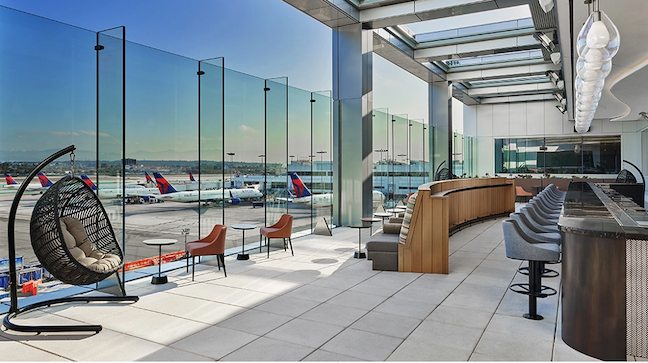
Delta SkyClub in John F. Kennedy Airport Terminal 4. Photo by Delta Airlines
So, what amenities in the new lounges will win back customers’ loyalty?
The new SkyClub in JFK is described as “a tucked-away nook with lush green seating evokes the elegance and privacy of a classic speakeasy” in a Delta press release. It is equipped with a glass-enclosed sky deck and food service from Elyssa Heller, founder and CEO of Edith’s Eatery & Grocery in Brooklyn.
The Chase Sapphire Lounge in Boston has a seasonal artisanal cocktail list, taproom and food from award-winning chef Douglass Williams for pre-flight fare; if you choose, you can enjoy your shrimp risotto Milanese in the serene wellness area filled with cushy massage chairs.
Powerful Plastic
There is an implicit connection being drawn between these new lounges and airlines’ top credit cards. AMEX’s Centurion Lounges are complimentary for their Platinum Card customers only, a card that boasts an annual fee of $695. The Chase Sapphire Reserve and Citi/AAdvantage Executive World Elite cards are $550 and $595, respectively, annually.
The lounges are impressive, and the price certainly reflects it. But there are lounges around the world that are more exclusive, more expensive, and more dazzling.
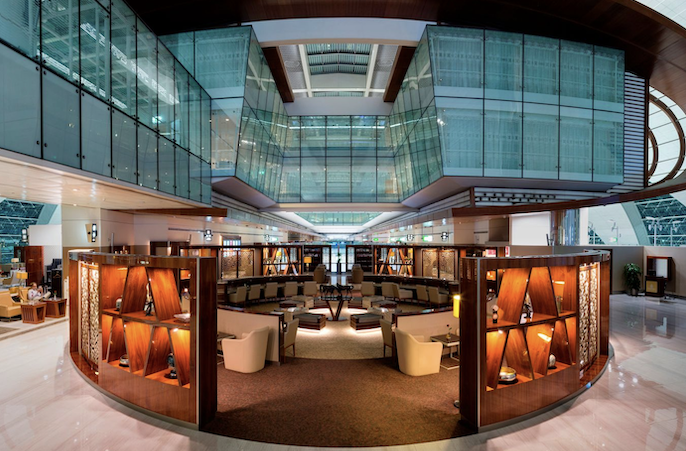
The enormous Emirates Lounge in Dubai has special sections for first and business class passengers. Sorry, all of you with economy tickets. These lounges are not for you. Photo courtesy of Emirates
The Emirates First Class Lounge in Dubai International Airport is a 100,000-square-foot colossus that was opened in 2016. Fit with in-house duty free shops, a wine-tasting room with a dedicated champagne bar, and a full-service restaurant opposed to the typical buffet-style fare, the lounge is the largest and perhaps most luxurious of its kind in the world.
At Lois Angeles International, the Private Suite Lounge (PS LAX) opened in 2017 as an entirely separate terminal for its members, who shell out $695 a year for a separate TSA and Customs screening center and individual suites. The membership is only for the one location and is likely targeted at the Hollywood stars and business elite of southern California.
PS plans to open a new location in Atlanta’s Hartsfield-Jackson Airport in September.
An Airport Quickie
United Airlines is showcasing some ingenuity in the lounge wars. Rather than chase exclusivity alone, the airline instead opted to curb the issue of overcrowding by opening its first Grab N’Go Lounge in Denver International Airport, a lounge that prioritizes efficiency.
“It’s almost like the airlines need to have two lounges – one for their frequent travelers and one for their credit card users,” opines Cosgrove, unknowingly siding with the recent move from United.
The Grab N’Go lounge is simple, providing prepackaged snacks and sandwiches, a small coffee bar, and some sparse accommodations. The club has just 16 seats inside and is marketed to passengers with quick connections or those looking to pop in for a pre-paid snack.
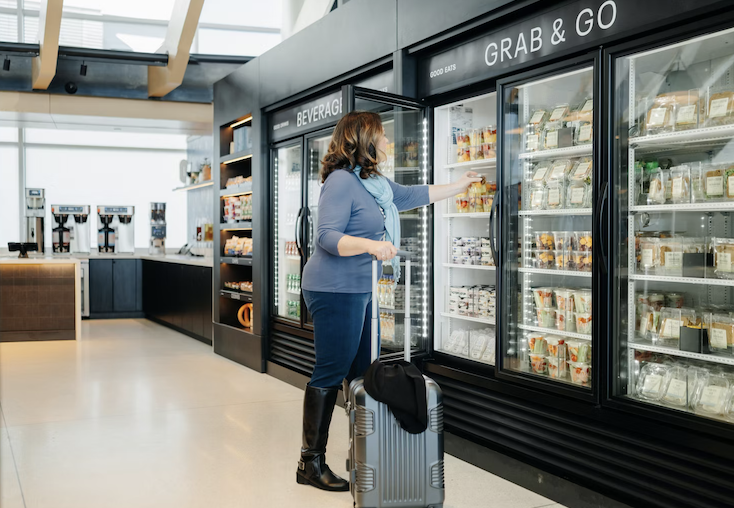
United Airlines’ Grab & Go lounge at Denver International caters to loyal passengers in a hurry to make their next flight. Photo by United
“We know there are times when our members are in a hurry and use our clubs to sneak a quick drink or snack, so we’ve created this new format to make it easy for them to do that without sacrificing an upscale club environment,” Marketing & Loyalty VP and MileagePlus President Luc Bondar said in a statement.
It may be a stroke of genius. Travelers with short layovers usually are interested in grabbing a cost-effective meal and a quick rest. But in so doing they can clog seats in full-size clubs and frustrate long-layover passengers. By offering different tiers and speeds of service, United hopes to decrease traffic in its larger lounges while simultaneously keeping other customers happy with more modest benefits.
Trouble in paradise
Airport lounges are trojan horses for airliners. The improvements are amazing for frequent travelers. Yet, they divert attention from the larger issue of how airlines’ funds are directed.
Other investments in passenger comfort are occurring alongside the building of new lounges. For instance, Delta’s new club is part of a $7 billion infrastructure upgrade to its New York terminals, which added more self-service check-in kiosks and new bag-drop locations.
Do these new investments in comfort make sense? The Southwest Airlines and FAA meltdowns of the past year showed that airline technology is laughably outdated. Delta, British Airways, JetBlue and others all have had IT meltdowns in the past decade, too. Necessary upgrades for safety software and plane management systems have been continually stalled despite large investments in terminal comfort.
The large sums associated with airport renovations are reflective of the motivations of airlines to quickly spur their profits, not to improve management systems that are long overdue for modernization. These choices relate back to a looming issue that has been swept under the rug for the past decade.
Delta and United both made the controversial switch to a revenue-based loyalty model in 2014, essentially replacing the long-used award charts that determined the valuation of point-related benefits. Other airlines quickly followed suit.
After the switch, airlines inflated their points to exorbitant values, legitimizing the switch by offering more attractive conversion points for their credit card purchases. In one move, airlines incentivized more cash purchases for their products while simultaneously removing mass quantities of points from circulation.
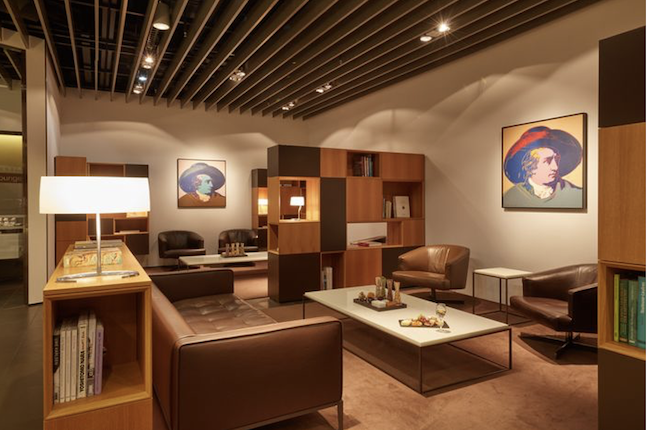
The Lufthansa lounge in Frankfurt is decorated with paintings by Dutch masters. Photo courtesy of Lufthansa
In 2018, there were an estimated 30 trillion unused frequent flyer points in circulation. Each point used is money lost for the airline. Financial documents released during the pandemic revealed that the U.S.’s top-5 most valuable airlines had a combined $27.5 billion in liabilities related to their rewards programs.
In short, if members were ever given the opportunity to redeem all their miles on a good deal, an airline could go belly up overnight. By continually placing their profits into benefits that appease top point earners, such as platinum and medallion lounges, airlines can continue the cycle of low redemption that frustrates lower-tiered customers.
Data released by airlines in their SEC filings reveals metrics that explain the growing issue. Of American Airline’s 115 million members, only 13 million miles were redeemed last year. Of United’s 106 million, only 6.8 million were redeemed. Those miles are also being cashed in large sums that can climb to 500 thousand miles for a single round-trip international flight.
Low redemption and high point sums have severely impacted the perception of the loyalty industry, especially among younger travelers. Millennials may be the least loyal travelers of any generation, with 47% of Millennials changing their airline loyalty compared to 23% of Generation X in 2022.
Getting the most from your loyalty
For elite cardholders and airline members who are willing to pay for entrance, you are getting better lounges. Although airline loyalty programs are in a precarious position, they are still ensuring that their facilities exceed satisfactory. But there are some strategies to avoid the trouble of airline loyalty these days.
The best way to avoid the low return on loyalty point redemption is to avoid co-branded loyalty cards altogether. Pledging allegiance to bank cards offered by JP Morgan Chase or Capital One now is the best bet for frequent travelers, despite what airlines may lead you to believe.
First, the loyalty points garnered from cards directly affiliated with a bank are more regulated than the co-branded airline points. Purchases with their points can be converted into travel spending at a much higher redemption rate than co-branded cards, yielding better returns for your spending in the long run.
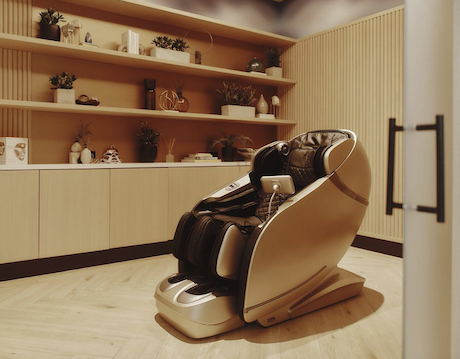
The entrance to the Chase Sapphire Lounge in Boston has several nooks and crannies for travelers awaiting their flights. Visitors can reserve 30 minutes in this Osaki massage chair free – if they ask at the right time.
Second, cards like the Chase Sapphire Reserve, American Express Platinum, or Capital One Venture X are structured with benefits designed for travelers. For instance, all three cards have reimbursement policies for airport delays that exceed 6 hours. If you need to stay overnight because of a delay, these cards could earn you $500 for a hotel room.
With the official entrance of banks like JP Morgan Chase and Citi Bank into the airport comfort sector, travelers can escape the perils of frequent flyer programs while still enjoying the benefits. More lounge competition could mean less waiting in line at the door, too.
Still, maybe it’s not enough. “I’ve never picked an airline because of their lounge,” says Cosgrove, “and I’ve dealt with banks long enough to know that having a lounge at the airport is not going to make me change banks.”![]()
James Cruikshank Jr. is a student at Duke University. His previous story for the East-West News Service examined the Butterfly Effect of the Georgia coast.

